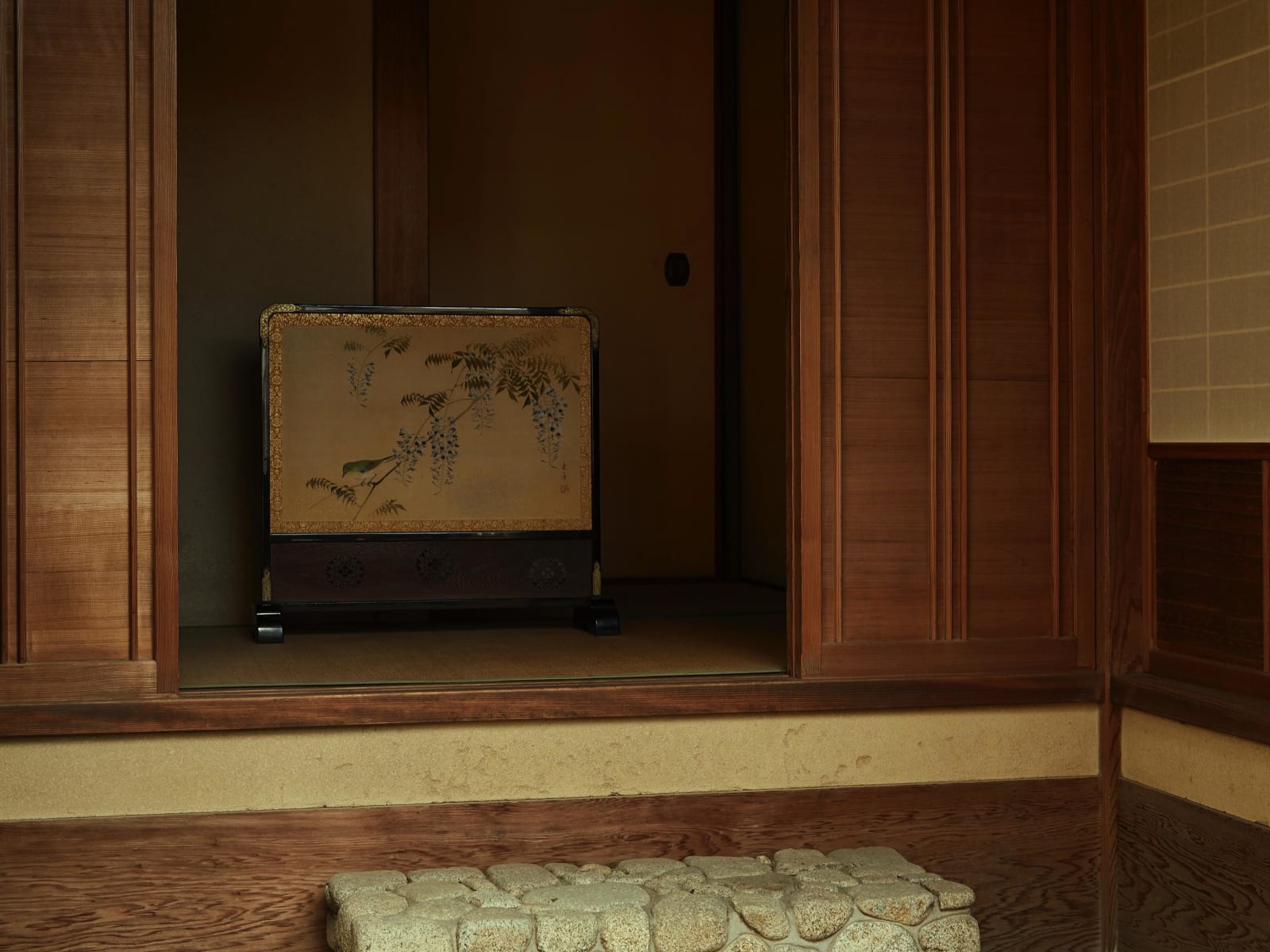Nakajima Raishō (1796–1871)
Wisteria and Quails
Color and gold on silk, standing screen
Seal: Minamoto Raisho in (each side)
36 x 56 cm
60.7 x 64 cm (overall)
Seal: Minamoto Raisho in (each side)
36 x 56 cm
60.7 x 64 cm (overall)
Exhibitions
Toshi Katayama Shigezaburo shi shozo momoyama byobu sonota Nakamura Tsuneshichi shi shin shoga oyobi toshi boke zohin nyusatsu. Kyoto: Kyoto Bijutsu Kurabu, 1918.
When it comes to the paintings of wisteria, Maruyama Okyo’s Wisteria, a pair of folding screens in the Nezu Museum recurs to the mind. Besides that, his works with the same subject mounted in hanging scrolls are not a few, in which flowers often appear together with birds. The present standing screen was painted by Nakajima Raisho, the third-generation of Maruyama school, of which the composition clearly inspired the present work. In contrast to Okyo’s trunk and branches depicted as a cascade of twisting vines, in Raisho’s Wisteria, the branches are strongly straight, extending diagonally from top, through the foot to the edge.
In Japanese paintings, the style of quail was stemmed from the Quail by Li Anzhong, a Chinese painter active in Southern Song dynasty, which was brought to Japan during the Muromachi period. Such a subject was especially favored by Tosa Mitsuoki and the Tosa school artists. Through centuries, the realistic portrayal of quail was nearly the same, regardless of period and genre. The exquisite depiction of the feathers was the highlight of the quail painting: whether the details of feathers are delicately reproduced shows the artist’s facility with capturing the nature. Raisho’s works on the subject of quail are surviving in great numbers, which proves that he was top-tier of this kind.
Raisho passed away in 1871; he can be called the last master of Maruyama school in the Edo period. Highly praised at that time, Raisho succeeded to the orthodox school tradition and rarely exuded an aura of modernity. While the recent tendency is to explore novel possibilities in art, Raisho received less attention from the public. Yet, when our senses are getting numb with the eccentricity, it might be refreshing to get into Raisho’s world suffused with a sense of tranquil repose.
Nakajima Raisho (painter; 1796–1871)
Also known as Shikei, Shunbunsai, Tsushindo.
Omi-born late Edo to Meiji period Maruyama school painter. His clan name is Minamoto. First learned painitng from Watanabe Nangaku and later became a pupil of Maruyama Ozui. Recognized as one of the four greatest masters during the late Edo period together with Yokoyama Seiki, Kishi Renzan, and Shiokawa Bunrin. Raised Kono Bairei and Kawabata Gyokusho as his disciples. Also known for his haiku writing.
In Japanese paintings, the style of quail was stemmed from the Quail by Li Anzhong, a Chinese painter active in Southern Song dynasty, which was brought to Japan during the Muromachi period. Such a subject was especially favored by Tosa Mitsuoki and the Tosa school artists. Through centuries, the realistic portrayal of quail was nearly the same, regardless of period and genre. The exquisite depiction of the feathers was the highlight of the quail painting: whether the details of feathers are delicately reproduced shows the artist’s facility with capturing the nature. Raisho’s works on the subject of quail are surviving in great numbers, which proves that he was top-tier of this kind.
Raisho passed away in 1871; he can be called the last master of Maruyama school in the Edo period. Highly praised at that time, Raisho succeeded to the orthodox school tradition and rarely exuded an aura of modernity. While the recent tendency is to explore novel possibilities in art, Raisho received less attention from the public. Yet, when our senses are getting numb with the eccentricity, it might be refreshing to get into Raisho’s world suffused with a sense of tranquil repose.
Nakajima Raisho (painter; 1796–1871)
Also known as Shikei, Shunbunsai, Tsushindo.
Omi-born late Edo to Meiji period Maruyama school painter. His clan name is Minamoto. First learned painitng from Watanabe Nangaku and later became a pupil of Maruyama Ozui. Recognized as one of the four greatest masters during the late Edo period together with Yokoyama Seiki, Kishi Renzan, and Shiokawa Bunrin. Raised Kono Bairei and Kawabata Gyokusho as his disciples. Also known for his haiku writing.



